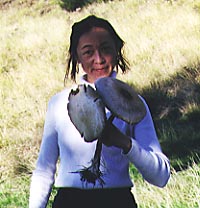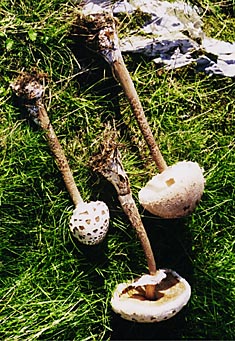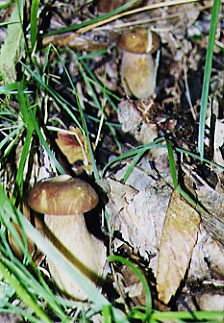

My wife and I had our honeymoon in northern Italy in October of 1999. As you can see, we found time to do a bit of hiking in the forests. October is porcini season in Italy, and the Italians are passionate about porcini. Wherever chestnut trees grow, you can find several cars parked beside trailheads, and the forests are filled with basket-carrying, stick-bearing elderly Italians (along with the occasional young fanatical Californian...) searching for their favorite edible perfume. But Boletus edulis isn't the only good mushroom that we found growing in the region of Lunigiana. In the mountains near Carrara, we found these huge Lepiota procera, much larger than any that I have found in North America. |
 |
| The prize! Boletus edulis. Somehow, these little beasties figure out the exact color that helps them disappear into the dense leaf litter of the chestnut groves. This is not a mushroom that you can easily discover by accident. You can walk right past them without seeing them. |  |
| Yum, complete with baby mollusk, competing for the same tasty bite of porcini. (Note the small slug near the base of the smaller mushroom.) |  |
| A number of different species of Boletus and Leccinum shared the forest with Boletus edulis. I have not identified the two species shown here, but they were associated with pine trees rather than chestnut. |  |
| Yet another species of Boletus growing near the porcini, resembling some that I have seen in California but not identified. |  |
| Amanita vaginata, growing in ivy and brambles at the edge of a Chestnut grove. |  |
| Ganoderma tsugai, the prized ling chi (reishi) medicinal mushroom, growing near an oak tree in the region of Umbria. |  |